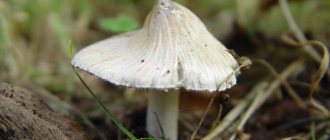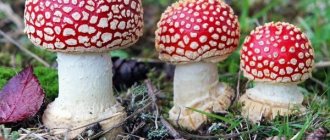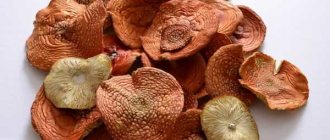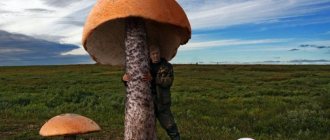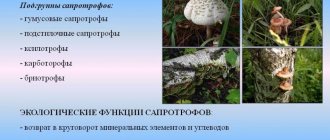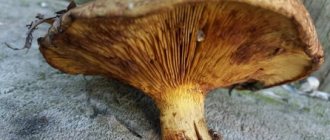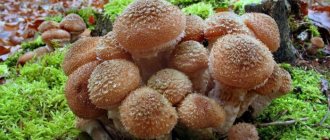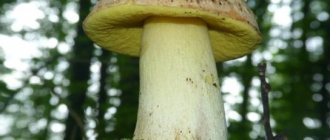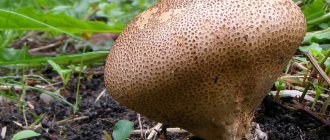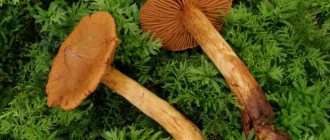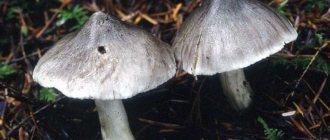Mushrooms occupy an important place in human life. Without penicillin and yeast, our existence would be more difficult. The tradition of eating them is not widespread in all countries, since they are a difficult product for digestion. There are more than 100,000 species, some of which are dangerous to humans.
There are no accurate global statistics on the number of people affected by mushrooms. So it is impossible to say for sure which of them is the most dangerous, with complete certainty. Even spoiled pickled edible mushrooms pose a threat. At the slightest suspicion, they should be thrown out; in extreme cases, simmer over low heat for at least 30-40 minutes. Botulinum toxin, which is destroyed under such conditions, is one of the most toxic substances in the world and was previously used as a biological weapon.
In addition, they can absorb harmful substances, so you should not pick mushrooms near roads and industrial facilities. Some participants in the list of the 10 most poisonous mushrooms in the world do not lose their dangerous properties even during heat treatment. And drinking alcohol only worsens the situation in case of poisoning, despite prevailing opinions. So the main rule is: “Don’t try unfamiliar mushrooms!”
What happens if you eat toadstool?
He is the most poisonous. When you come into contact with it, particles of poison remain on your hands. You can’t collect toadstools, like other things growing next to it.
If you do not find a dangerous species in the basket and eat it, you should immediately go to the hospital.
Before going to the hospital, induce a gag reflex and let everything out. On the way to the hospital, drink more clean water and activated carbon. Do an enema, gastric lavage. Contact your doctor immediately.
Popular articles: Infographics. Friends are chosen. Survey
Fly agarics
We put these mushrooms in second position because some of them are deadly poisonous. Many people imagine him as a real handsome man with a red hat with white dots. In fact, fly agaric is not one mushroom, but an entire genus, numbering about three dozen species. Among them there are the following groups:
Red fly agaric hallucinogen
Edible and even delicacy (fly agaric imperial and caesar mushroom) . Conditionally edible (float or fly agaric Sicilian, ovoid, solitary, gray-pink).
Amanita panther poisonous
Simply inedible, although not poisonous (fly agaric, yellow-green, bristly, spiny-headed, gray, purple, knobby, thick and others).
Toxic. To be fatally poisoned, you need to eat a lot of them, but in moderation they are hallucinogenic.
Amanita toadstool poisonous
This is the well-known fly agaric with a red cap with white speckles. It is widely used in medicine, as a medicine, for example, against cancer, and in everyday life for baiting insects. Hence its name. But there are also unusually dangerous species in the genus. There aren't many of them.
Amanita stinking poisonous
The list of poisonous mushrooms includes royal fly agaric (not to be confused with imperial), spring (or white), stinking (or stinking toadstool) and panther. Each of them contains the poisons muscarine, muscaridine, and some additionally contain hyoscyamine and scopolamine.
Poisoning with these fly agarics is fatal in 9 out of 10 cases.
Short description
I would like to warn you that only those who are perfectly versed in them can collect fly agarics for food, because in many ways the “bad” and “good” species are quite similar.
Let's talk about the characteristics of poisonous representatives. Spring fly agaric. Some call it the spring toadstool. It can also be said that it is the most poisonous mushroom in the world. Its cap is white, slightly creamy in the center.
At first it is convex, then becomes almost flat. Its diameter can be up to 10 cm. The flesh of the mushroom is white, odorless, and unpleasant in taste. The leg extends up to 12 cm in height.
It varies in thickness (from 7 to 25 mm), but always has a white “skirt” and a thickening closer to the ground. The fly agaric is smelly. This mushroom is all white.
The spherical cap can be up to 11 cm in diameter, the stem reaches a thickness of up to 20 mm. A distinctive feature is that the pulp smells of chlorine. Panther fly agaric.
It is also considered one of the most poisonous mushrooms in the world, since when poisoned with it, death occurs in 90% of cases.
Outwardly, it looks a little like the red fly agaric, only its cap can be gray, brownish, greenish, or light brown. Along its edges there are often flakes hanging from the bedspread.
The pulp is white and does not change color in the air. Its consistency is slightly watery, foul-smelling, and sweetish in taste. The leg is most often thicker at the bottom, slightly fleecy, and has a white ring-shaped rim at the bottom. Some specimens have a white, fragile ring on it.
Royal fly agaric
This is a real giant, reaching 20 cm in height. The diameter of the cap can also be about 20 cm. This mushroom is hard to miss. Its cap can be ocher, brown or greenish, and its shape is flat, spherical or depressed in the center, with radial stripes.
Popular articles: Expedition recipes. Secrets of Tibetan medicine
Fly agaric Caesar
On top it is covered with white “dots” (remnants of the bedspread). The pulp ranges from light yellow to brown, odorless. The leg is thick, whitish, thickened downward, velvety, and has several belts.
Fly agaric float
A distinctive feature from the imperial fly agaric is that the cap of the latter is bright orange or ocher, without white dots.
Gray-yellow false honey fungus
Many people mistakenly call these mushrooms toadstools. They grow on long thin legs (up to 10 cm). Moreover, the diameter of the caps is only 2-4 cm (very rarely up to 7 cm).
The color of the cap comes in different shades - grayish, beige, brownish, even greenish, but always with a yellowish tint. There are plates under the cap. In young mushrooms they are white-yellow, but soon become dark, rich brown. The pulp is very bitter and smells unpleasant.
False honey fungus gray
It's hard to imagine that anyone would want to eat such a mushroom. Nevertheless, cases of poisoning by gray-yellow honey mushrooms are not so rare. The first symptoms (vomiting, diarrhea, pain, dizziness) manifest themselves 5-6 hours after the meal. Death occurs in approximately 60% of cases.
Characteristic signs of poisonous mushrooms
Of the 100 thousand mushrooms known to scientists, only a small percentage actually threatens human health. Thus, out of 5,000 species growing in European forests, only 150 are not suitable for human consumption. However, the same species can be divided into harmless and toxic. Only an experienced mushroom picker can notice the difference between them.
First of all, you need to carefully consider the appearance of the mushroom:
- coloring of the cap and plates;
- leg shape;
- condition of the pulp when cut.
The presence of a fringed “skirt” under the cap and a “bag” seal at the bottom of the leg should alert you. The claim that poisonous fruits necessarily emit an unpleasant aroma is just a myth. For example, toadstool may have a neutral odor, even similar to the smell of champignon.
Galerina bordered
This is also a type of false mushrooms; in Russia it is found in the Caucasus.
Galerina can be safely called one of the most poisonous mushrooms in the world, since poisoning with it is fatal in 90% of cases. This false honey fungus can grow either in a family or alone. It has a convex cap up to 4 cm in diameter, a long stem (up to 7-10 cm). The color of the cap can be from pale yellow to brown-orange, and it changes depending on the humidity.
Galerina bordered
The outside of the cap is almost always oily or covered with sticky mucus. The pulp is white or light brown, with the smell of flour. It contains deadly poisons amitoxins.
False honey mushrooms brick
Psilocybe semilanceolate
Psilocybe semilanceata is the most hallucinogenic mushroom popularly called “merry mushroom”. In a small dose it causes invigorating states associated with hallucinations, in a larger dose it causes poisoning. Although it is difficult to be fatally poisoned by it, the line between uplifting feelings and poisoning is very thin and individual. You can cause serious injury to yourself while the drug it contains is in effect. As a result of consuming this mushroom, both euphoria and depression with suicidal tendencies can occur. That is, the effect of consuming these mushrooms is not always desirable.
Pig
Pig mushrooms were included in the list of poisonous mushrooms only in 1944.
Before this, they were considered conditionally edible. The fact is that they contain a special antigen that sticks to our red blood cells, thereby causing an autoimmune response in the body.
Pig
As a result, a person develops hemolytic anemia, renal failure, and nephropathy. For this to happen, pigs need to be eaten for a long time (until their antigens accumulate in sufficient quantities).
Popular articles: Noah's Ark Ararat. Scientific evidence for the existence of the flood
Fat pig
Many people, having eaten them once, do not experience any painful symptoms, so no one associates the death with the pig. Death most often occurs in children and people with kidney problems. Externally, the mushroom is quite nice and very similar to a good one.
It has a thick short leg, a fleshy large cap (up to 15 cm in diameter), which can be slightly convex or flat. Its color varies from olive-brown to rusty-brown. The pulp at the site of damage (pressure) quickly darkens. You can often see worms and insects in it.
Using the example of a pig, we can say that the signs of poisonous mushrooms do not always work. If you focus only on whether the caps are wormy or not, you can make a fatal mistake.
Ergot purpurea
Ergot purpurea is a type of parasitic fungus that is found on some grasses and grains, most commonly rye. The mushroom is purple in color, it is located in ears instead of grains, and its shape resembles a tooth. Alkaloids contained in ergot have a psychotropic, neurotoxic effect on the central nervous system. In large doses it is toxic to humans and, if ingested, causes convulsions, prolonged spasms, mental disorders, and often death. It is known that in the Middle Ages epidemics occurred among people and animals due to the consumption of rye bread, which was made from infected grain. The epidemic is known as "Saint Anthony's fire" or "sacred fire".
2
Omphalote olive
This mushroom is considered by some to be one of the most poisonous mushrooms in the world, because symptoms of poisoning (vomiting, diarrhea, salivation, sweating, irregular pulse, blurred vision and breathing) occur within 15 minutes after eating.
Omphalote olive
However, it rarely ends in death. Usually the victim’s health is restored within a day.
In Russia, olive omphalot is found in Crimea. Outwardly, it looks a little like tinder mushrooms. Grows on stumps, logs, trunks of deciduous trees. Its leg is very short (up to 3 cm), but can be barely noticeable.
The cap reaches a diameter of 12 cm. It is smooth to the touch, less often finely scaly. Its color is always orange with the addition of red or yellow. A distinctive feature of the olive omphalot is that its plates glow in the dark.
Fifth place - whitish talker
0
This mushroom is widespread, found not only in forests, but also in fields, clearings, and parks. Rarely grows alone, more often found in colonies, growing in rings. It can be seen from mid-summer until October. It has a light convex cap with a grayish coating, growing to its maximum, it becomes funnel-shaped. It has a soft leg that darkens when pressed, and even in its usual form it has an abundance of spots. An eaten mushroom causes a strong decrease in blood pressure, an increase in heart rate, and sweating. Tears may come from the eyes. Hospitalization and gastric lavage are necessary, and the patient is also given an antidote to save his life.
×
Gindellum Peca
Each country has many of its own poisonous mushrooms.
Of interest is the species Gindellum Peck, named after the scientist - mycologist. In Russia, it is extremely rare in Crimea and the Caucasus.
Many consider it the most poisonous mushroom in the world and even attribute mystical properties to it, because it is capable of secreting a red liquid similar to blood. Due to this, it is called the bloody mushroom or bloody tooth.
Gindellum Peca
In fact, Gindellum Peca is not poisonous. Some people eat it after careful cooking. But there are few of these, since its pulp is very bitter.
Distinctive features Of course, it is important to know how to distinguish poisonous mushrooms. Outwardly, they can be very similar to edible ones (for example, false chanterelle, burning russula, greenfinch).
Only experienced mushroom pickers can recognize them. Pale toadstool is distinguished from champignon by the color of the plates, which are white in the poisonous mushroom and dark in the champignon. The flesh of the toadstool is not as brittle as that of the russula, and the greenfinch, unlike the toadstool, does not have a vulva. The external differences of other types of mushrooms may be different.
What they have in common is that poisonous species are never worm-like. Some “cooks” test toxicity using an onion.
To do this, place it and the mushrooms in a container of water. If the bulb has darkened, then the contents of the container should be thrown away. Please note that these comparisons and experiments can be fatal.
Therefore, it is better to avoid questionable mushrooms.
Poisoning
This deadly poisonous mushroom is dangerous not only because it looks like an edible one. Its insidiousness lies in the fact that the first signs of poisoning (uncontrollable vomiting, bloody diarrhea, severe pain in the peritoneum and muscles, heart failure, hypotension, threadlike pulse) appear only a day or two after eating toadstool, when the liver and kidneys are already heavily damaged. Another unpleasant nuance of poisoning is that on the 4th day there may be an unexpected improvement in the condition, which sometimes lasts for several days. After this comes death. Lethal outcome from poisoning with pale toadstools is recorded in 99% of cases.
